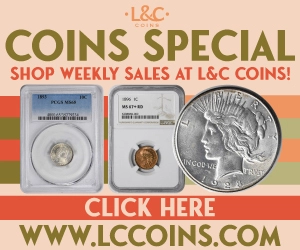1982 was a landmark year for the United States one-cent coin, as the metallic composition of the coin was changed from bronze to copper-plated zinc. It was the end of an era for the “penny,” which had become too expensive to produce with its 95-percent copper composition; the cost of making the one-cent piece was approaching the coin’s face value. Eight years earlier, the U.S. Mint experimented with using an aluminum composition for the one-cent coin as copper prices tripled over the course of less than 18 months.
Due to logistics issues concerning the use of aluminum one-cent coins in vending machines and a significant decrease in copper prices, the Mint continued production of the bronze cent. By 1981, the soaring price of copper prompted the U.S. Government to reconsider the denomination’s bronze composition, and a 97.5 percent zinc, 2.5 percent copper composition was authorized.
The new zinc-based Lincoln cent (the “zincoln”) was a late-year replacement for 1982, and the first zinc cents were struck during October of that year.
Related Articles on CoinWeek – The Coin Analyst: 1982 Lincoln Cent Provides Collectors with Challenges, Rewards
Design
Obverse:
The obverse of the 1982 Lincoln cent was designed by Victor David Brenner and appears largely as it did when the type was first minted in 1909. The main difference on the 1982 obverse versus the 1909 version is the location of Brenners’ initials, V.D.B., which were added under Lincoln’s bust in 1918 after their removal from the reverse in late 1909. The date, 1982, appears to the right of Lincoln and the motto IN GOD WE TRUST appears above the president. On the left of the 16th president is the word LIBERTY.
Reverse:
Frank Gasparro designed the Lincoln Memorial reverse seen on the 1982 one-cent coin. The Lincoln Memorial reverse replaced the wheat stalk design, a Brenner original from 1909, in 1959. Gasparro’s initials FG appear on the lower-right side of the Lincoln Memorial. Below the edifice and along the rim are the words ONE CENT, while the legend UNITED STATES OF AMERICA run along the top half of the reverse along the rim. Between the top of the Lincoln Memorial and UNITED STATES OF AMERICA inscription is the motto E PLURIBUS UNUM.
Edge:
The edge of the 1982 Lincoln Memorial cent is plain, or smooth.
Designers
Lithuanian-born coin designer Victor David Brenner is best known for his iconic design for the Lincoln cent (1909-Present) (View Designer’s Profile).
Frank Gasparro was an American medalist and the 10th Chief Engraver of the United States Mint from 1965 to 1981 (View Designer’s Profile).
Coin Specifications
| Country: | USA |
| Year Of Issue: | 1982 |
| Denomination: | One Cent |
| Mint Mark: | P, D, S |
| Mintage: | 10,712,525,000 (P), 6,012,979,368 (D), 3,857,479 (Proof; S) |
| Alloy: | 95% copper, 5% tin and zinc; 97.5% zinc, 2.5% copper |
| Weight: | 3.11 grams (bronze); 2.5 grams (zinc) |
| Diameter: | 19.05 mm |
| Edge: | Plain |
| OBV Designer | Victor David Brenner |
| REV Designer | Frank Gasparro |
| Quality: | Business Strike, Uncirculated, Proof |

A notable fact not mentioned in the article is that new dies combined with the changeover from bronze to zinc resulted in _seven_ major business strikes combinations:
– Philadelphia Large Date Bronze
– Philadelphia Large Date Zinc
– Philadelphia Small Date Bronze
– Philadelphia Small Date Zinc
– Denver Large Date Bronze
– Denver Large Date Zinc
– Small Date Zinc
I have 1982 penny small and large date that weighs in at3.11 grams as well as ,A 1982 D small date.so what does that mean than?
I have a penny that looks silver from 1982. Far as. I can tell its not coated
I have one also. I wonder what an uncoated cent is worth.
Actually, since 1962 the cents weren’t bronze they were brass, they had no tin in them.
I have an 1982 Penny weight ,3.1 and d mint mark
I have 1982 d bronze weighs 3.08 grams
I have a 1982 small. Date ddo ddr copper
I would like to know do I need the d mint mark for this one cent to be worth $50-$75?
Sorry Michelle billions of Denver mint coins were minted. This is not valuable. None of the others mentioned in this thread are likely to be either.
The Lincoln penny has never had a reeded edge. That edge can be seen in Mercury and Roosevelt dimes, Washington quarters, Barber, Walking Liberty and Franklin half dollars, among other modern coins.
Sorry about that guys, it was a copy and paste error that got reverted somehow. Fixed, and it should stay fixed this time.
Please reminds us of the difference between large and small date on the copper 1982 penny, and is the small date much more valuable, right?
How much is the 1982 penny worth?
I think I may have this coin. How do I know? Id lime to send you pictures if your okay with that.
I have a 1982 penny with no mint in small numbers.